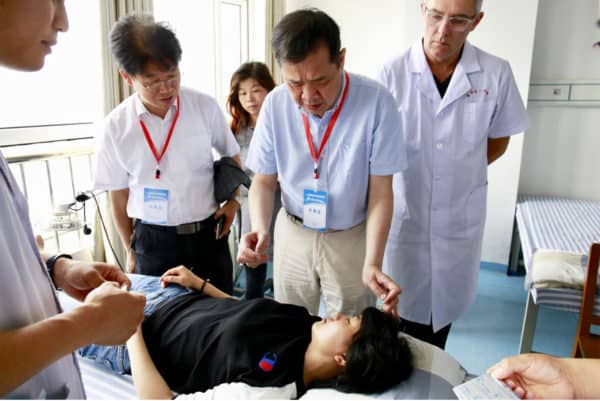Menstrual pain can be debilitating for those experiencing primary dysmenorrhea.
Acupuncture in patients with dysmenorrhea: a randomized study on clinical effectiveness and cost-effectiveness in usual care.
Claudia M.Witt, MD, MBA; ThomasReinhold, MSc; Benno Brinkhaus, MD;
StephanieRoll, MSc; Susanne Jena, MSc; Stefan N.Willich, MD, MPH, MBA
CONCLUSION:

Patient receiving acupuncture for Primary Dysmenorrhea
Reference
At the end of the 3 months treatment phase, although the pain outcomes were marginally lower for women in the acupuncture group, there were no significant differences between groups (Figure 2). Women reported fewer mood changes in the acupuncture group (53%) compared with the control group (72%), 0.72, 95% CI 0.53–1.00, (Figure 3).
Six months following trial entry, there was a significant reduction in the duration of menstrual pain in the acupuncture group (30 h) compared with the control group (39 h). There was a reduced need for additional analgesia in the acupuncture (54%) compared with the control group (82%), 0.69, 95% CI 0.49–0.96, The intensity of pain was lower for women receiving acupuncture, but not significantly different to the control group.
At the 12-month follow-up, the earlier improvements reported by women in the acupuncture group were no longer sustained, and there were no differences between groups. The intensity of menstrual pain, duration of pain, and the presence of other menstrual symptoms (Figure 4) reduced over time from trial entry for both groups.
Acupuncture to Treat Primary Dysmenorrhea in Women: A Randomized Controlled Trial
Caroline A. Smith,1 Caroline A. Crowther,2 Oswald Petrucco,3 Justin Beilby,4 and Hannah Dent5
Acupuncture to Treat Primary Dysmenorrhea in Women: A Randomized Controlled Trial
OBJECTIVE:
The aim of this study was to evaluate the effect of acupuncture (AP) in the treatment of primary dysmenorrhea (PD).
METHODS:
A clinical perspective, placebo-controlled trial included 57 women with PD. Of these, 30 were treated with manual AP points listed below.
Du 20 (Baihui), bilateral Li 4 (Hegu), Ren 3 (Zhongji), Ren 4 (Guanyuan), Ren 6 (Qihai), bilateral Gb 34 (Yanglingquan), bilateral Ub 23 (Shenshu), bilateral Lp 6 (Sanyinjao).
Auriculoacupuncture points (Shenmen); 27 women were treated with placebo AP.
RESULTS:
The occurrence of PD in nulliparae was statistically relevant (p < 0.001). Statistically relevant was also the decrease in medication in women to whom AP had been applied (p < 0.0001), which was not the case in the placebo group (p > 0.5).
CONCLUSION:
The success rate of AP for the treatment of PD symptoms within 1 year after the AP treatment is 93.3% in the first group and 3.7% in the placebo group.
Reference
Efficacy of Acupuncture for the Treatment of Primary Dysmenorrhea.
Acupuncture in patients with dysmenorrhea:
A randomized study on clinical effectiveness
and cost-effectiveness in the usual care.
Claudia M.Witt, MD, MBA; Thomas Reinhold, MSc; Benno Brinkhaus, MD;
StephanieRoll, MSc; Susanne Jena, MSc; Stefan N.Willich, MD, MPH, MBA
CONCLUSION: Additional acupuncture in patients with dysmenorrhea
was associated with improvements in pain and quality of life.
Reference